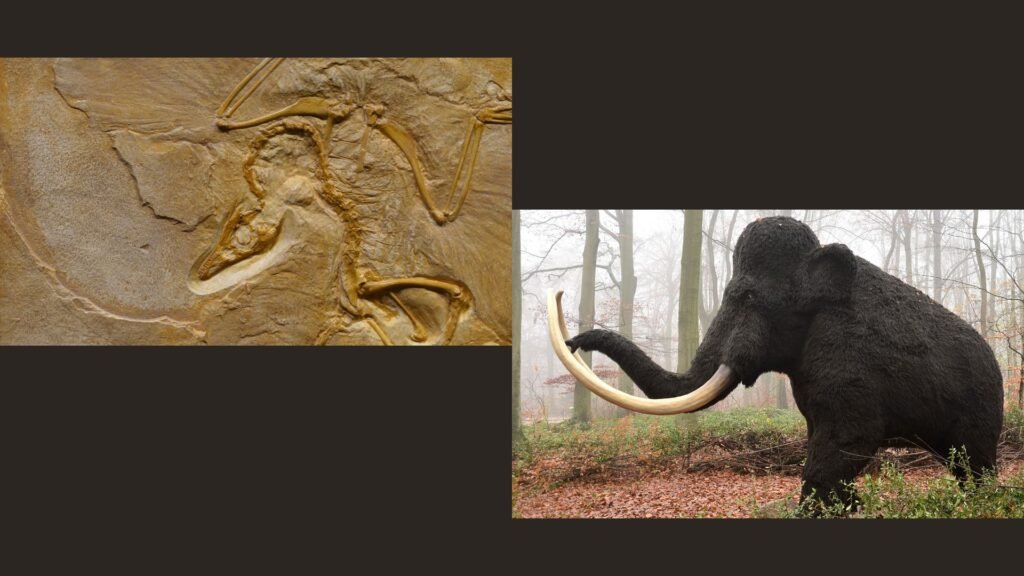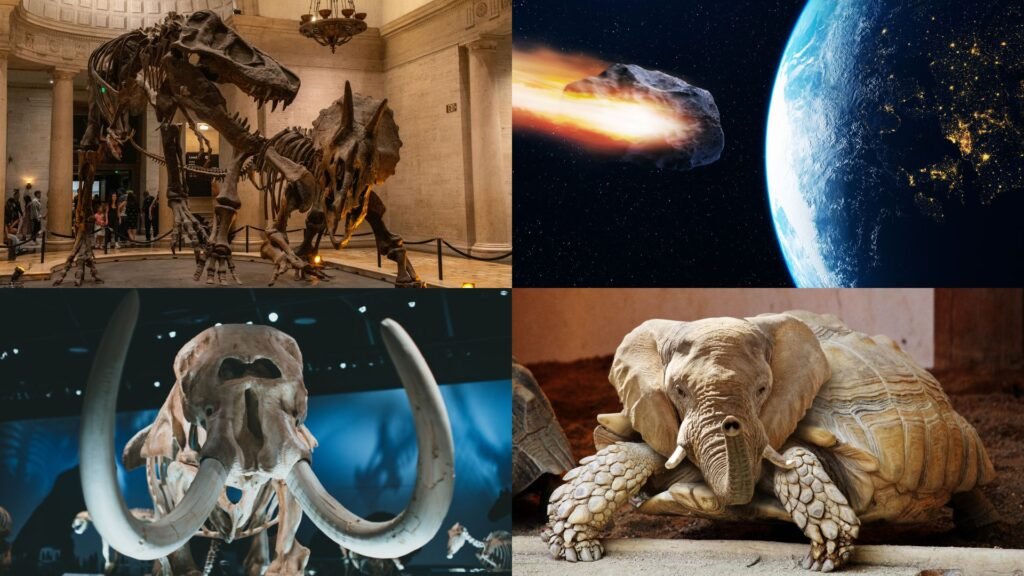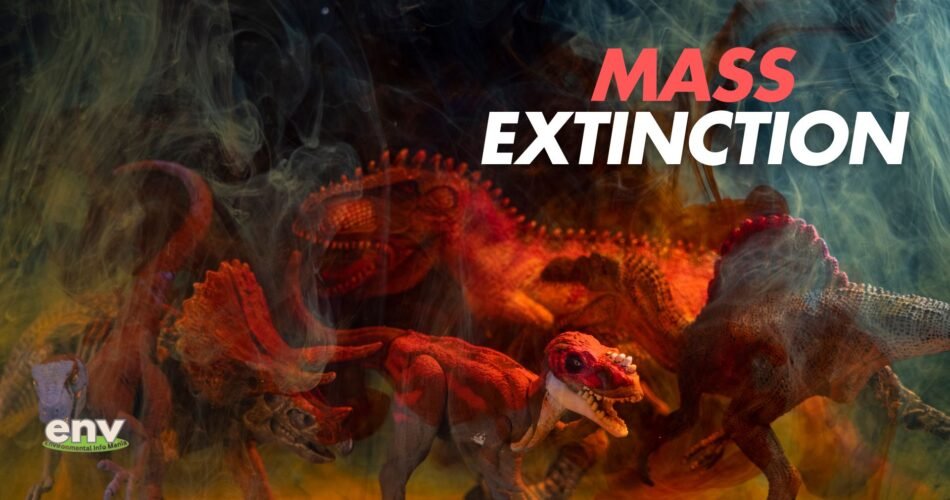This blog contains information about the Causes and Impacts of Mass Extinction. It also contains the explanation of Extinction and Factors influencing Extinction. It also discusses the Five Major Mass Extinction.
I. What do you know about Extinction?
Extinction is the condition in which there is a complete disappearance of a specie from the Earth. It occurs when the last individual of a certain species dies and is no more on the planet.
This process is continue from start of the Earth’s era. It is the situation in which any specie that existed on earth in large number, vanishes from the planet due to different reasons. The extinction may occur as a result of drought, waste shortage, Habitat loss and many other such phenomena. Millions of species still exists on Earth and many of them are already extinct. Extinction is also harmful for the surroundings and Biodiversity. It is harmful because every specie has its role in maintaining the Environment and keep the working of an Ecosystem. When a specie become extinct, their respective roles in the surroundings are also effected in this way and the whole living system is disturbed. Following are some of the species that are extinct on Earth.
Examples of Extinct Species:
Following are some examples of Extinct Species:
- Passenger Pigeons
- Dodo
- Great Auk
- Dinosaurs
- Woolly Mammoth
- Golden Toad
- Quagga
These are few extinct animal species. These are disappeared completely from the earth and are not seen for a long-time. This blog is all about Causes and Impacts of Mass Extinction.
“Big Five” Mass Extinctions:
There are five major Mass Extinction occurred on the Earth. The details about them are in the following section:
i. End Ordovician
This was the first mass extinction on Earth that occurred 444 million years ago. The timescale of End Ordovician period lasted for about 41.6 million years. In this era, intense glacial and interglacial periods created large sea level swings and moved shorelines dramatically. A lot of weathering was observed, CO2 sequestration, oceanic chemistry changed and changes in climate occurred. 86% of the species were lost in End Ordovician period.
ii. Late Devonian
Late Devonian mass extinction was the second one and it occurred about 360 million years ago. The timescale of second extinction was 23.8 million years. This period is associated with the rapid growth and also diversity of plant species generated on land. It created a severe Global Cooling on Earth. About 75% of the species were lost in this era. 70-85% marine species were lost in this major extinction period on the planet.
iii. End Permian
This extinction period was held about 250 million years ago. The timescale of End Permian was recorded about 47 million years. The third mass extinction was characterized by great volcanic activity in Serbia. This rapidly elevated CO2 and sulfur levels that lead to Ocean Acidification, Global Warming, Acid Rain, changes in oceanic chemistry and land chemistry at great extent. About 96% of the species were lost in End Permian period.
iv. End Triassic
End Triassic is the fourth mass extinction recorded on Earth that was about 200 million years ago. The timescale of fourth extinction period was about 50.6 million years. In this era, underwater volcanic activity took place in Central Atlantic Magmatic Province (CAMP). This elevated the effects of Global Warming and with that it highly ruined the chemical composition of the oceans to dangerous levels. 80% species were lost in this time period.
v. End Cretaceous
This is the fifth mass extinction era that held about 65 million years ago. End cretaceous have the timescale of 79 million years. This era is specified with the Asteroid Impact in Yucatan Mexico. It became the major cause of instant Global Cooling and cataclysm. A theory says that, intense volcanic activity was observed in Deccan Traps, India during this period and tectonic uplift was observed. There was a loss of about 76% of living species on earth.
These are the “BIG FIVE” Mass Extinctions on Earth. This blog is all about Causes and Impacts of Mass Extinction.

II. What are the Factors that influence Specie Extinction?
Extinction can be influenced by a number of factors. These factors play significant roles in the Specie Extinction. Following is the detail of the Factors influencing Extinction process:
Environmental Changes:
Every specie lives its respective Environment and is highly influenced by the Environmental conditions such as Pollution, Climate Change, Extreme Temperatures, Habitat loss and many other such phenomena that influences by the Environmental Changes. This can be extreme Weather events that can make lives of the organisms very difficult that they are unable to survive in their Habitat and also the Environment. This can be a significant cause of Extinction of a Specie.
Evolutionary Changes:
Evolution means changing in species and their traits with passing time in context of the stronger traits and weaker traits. These changes may be in positive ways or in negative ways. When it occur in negative way it results in weaker development, poor reproduction, population decline and many other such consequences that influence the destruction of the species. These changes may result in the specie endangerment and at the end, it may cause Specie Extinction.
Natural Disasters:
Natural Disasters are the result of Extreme Impacts of Climate Change that becomes the cause of destruction on Earth. These disasters includes Floods, Earthquakes, Tsunami and many other such Disasters that can kill thousands of individuals of a specie within minutes or hours. The Natural Disasters may destroy the Habitat of the species and can be the cause of Habitat Fragmentation. These can be a great cause of Specie Extinction.
Anthropogenic Activities:
Anthropogenic activities means the roles and activities initiated by humans for their welfare and development. These activities play as significant role in damaging the foundation and the roots of the species. There are a lot of human activities that harm the species. These include Hunting, Deforestation, and many other such activities that cause the destruction of species. In severe cases it can lead to Specie Extinction at great levels. The only way to control it is to ban hunting and Biodiversity Conservation.
These are the few Factors that Influence the Specie Extinction. These factors can cause Minor or Major damage to the species and can be very dangerous. This blog is all about Causes and Impacts of Mass Extinction.
III. What is the definition of Mass Extinction?
Mass Extinction is the phenomena in which there is a significant increase in the number of species that go extinct over a relatively short Geologic Time. These are critical intervals of Earth’s History.
Mass Extinction is a period of Biodiversity loss in which most prominently there is the loss of a large number of individuals of a single population. This phenomena is dangerous as it harms the Environment by quickly vanishing a population from the Earth. With the vanish of population, the Ecosystem services by the population also gets disturbs and eliminates. The massive extinction is great event in which the Nature loses individuals of a single population in bulk that is devastating for the Environment and the living system. This Extinction is a serious Environmental issue and also acts as the destruction of a specific specie over a short period of time.
This process of vanishment of the species can take thousands of years in normal conditions. But in case of Mass Extinction, it can be with in hundred years or even decades. This blog is the complete explanation of Extinction, Factors influencing Extinction, Causes and Impacts of Mass Extinction.
IV. What are the Natural Causes of Mass Extinction?
Mass Extinction is not as the concept of extinction. It needs great destruction to cause Mass Extinction because it is not the loss of few individuals of a population, but it is great loss of a significant amount of Biodiversity on Earth. So, the cause must be extreme or destructive events that results in this Extinction. Following are the Major Causes:
1. Volcanic Activity:
Volcanic activity includes the Volcanic eruption, Earthquakes and the destruction caused by lava when exposed to the surface of the Earth. This lava can destroy all the Biodiversity in its nearby areas or the areas by which it passes. Volcanism also adds severe Air Pollution to the Environment that can spread infections and Respiratory disorders to the animals. Any of these scenarios can be a cause of Mass extinction on Earth.
2. Asteroids and Comets:
The Asteroid and Comets are Space Objects that are present outside of Earth’s Atmosphere. These space objects when hit to the surface of the Earth, they cause severe Environmental Conditions. The Asteroid impacts includes Climate Change, Property damage, Dust and Smoke and eventually also a great cause of Mass extinction. This can alter the normal Environmental Conditions of a place and also may cause extreme Weather conditions that can cause massive death of Biodiversity.
3. Change in Atmospheric Chemistry:
Atmosphere is the envelop around the Earth that is made up of different gases in order to protect Earth from harmful radiations of the sun and other Electromagnetic Activity in the space. Atmospheric chemistry should be balanced and also maintained by the sufficient concentrations of different gases that helps it to stay rigid against all dangers from space to the Earth. The changes in Atmospheric chemistry may lead to Extreme Weather Patterns, Global Warming, Air Pollution and so many other conditions that can be a serious cause of Mass Extinction.
4. Changes in Oceanic Chemistry:
Oceans cover over 70% of the Earth’s surface. This is the reason that any slight change in the Oceans cause a lot of harmful effects on the Biodiversity on Earth. It is the biggest Natural Carbon sink and it absorbs the excessive Carbon Dioxide from the atmosphere in order to reduce Global Warming. But it cause Ocean Acidification at great levels. This can cause Mass Extinction by disturbing Ocean Currents and damage of Coral Reefs that facilitates 75% of the Marine Species.
5. Decreased Oxygen level:
Oxygen is the most important gas in our Environment. It helps the living organisms in Respiration and help them survive on Earth. O2 levels are extremely important in maintaining the Environmental Conditions fit and suitable for Biodiversity. The decreased oxygen level is a severe Environmental Condition for the Biodiversity. It can cause infections, diseases, respiratory conditions and so many other health effects that can be the Cause of Mass Extinction on Earth.
6. Climate Change
All of the impacts are basically the result of extreme climate change on Earth. When the temperature and weather patterns shift rapidly within short intervals, this includes in extreme climatic conditions. These can be a major cause of Mass extinction and if another era of extinction will occur, it will be the leading cause. Many species migrate, get harmed and face illnesses because of abrupt changes in climate. Although it is the major Environmental issue of the present time.
These are few main Causes of Mass Extinction. These can cause Severe conditions of Mass Extinction and also can cause great Biodiversity Loss on the Earth in a very short geological period. This blog contains Causes and Impacts of Mass Extinction.
V. What are the Human-driven Causes of Mass Extinction?
Following are the human-induced causes of Mass Extinction:
Habitat Destruction and Fragmentation
Modern Development requires planning and space for construction projects to make their lives easier and more developed. These activities often distribute the major habitats such as forests, biodiversity hotspots etc. into fragments. This condition is fragmentation. Fragments of habitats highly effects the reproduction and health of species and they eventually die. In the same way, deforestation and wetland destruction directly ruins the habitat of rear species on Earth. This leads to mass extinction.
Over-use of Resources
The over-utilization of resources is common in present human life. This is the main reason why species are getting extinct due to human activities. Resources are must for the development, industrialization and for making goods and products. It includes food, accessories, wood, chemicals, and medicinal resources from living species. This contributes in habitat loss, food insecurity and other major damages to natural ecosystems. The consumption must be in limits, otherwise this can cause massive extinction.
Pollution
Pollution completely relies on humans and their activities. Industries pollutes the air by adding Greenhouse gases into the environment. This cause illnesses and in extreme conditions i.e. Smog, it can cause death of sensitive organisms. In the same way, chemical waste and agricultural runoff lead to water pollution harming the lives of aquatic species at great levels. Plastic and other wastes when added into a natural ecosystem can be carcinogenic and fatal for the species leading to extinction and endangerment.
Enhanced Greenhouse Effect
Although Greenhouse effect is a natural process of heating on Earth, but it is much enhanced by human activities and modern development. Greenhouse gases from industries, construction sites, paints, transportation, agriculture and other non-sustainable activities, so lead to extreme impacts of Climatic Change on Earth. This increase Global Warming, Glacier melting, Heat Waves, Water Shortage etc. that are life threatening for species living in natural environments. These acts are increasing Climate Change and causing extinction as a long-term impact.
VI. What are the Major Impacts of Mass Extinction?
Mass Extinction has very bad impacts on the Environment and Biodiversity. These impacts can cause great damage to the nature by destroying it. Following are the Major Impacts of Mass Extinction:
Ecological Changes:
Ecological Changes means the alteration or variation in normal Ecological Cycles and Services. These changes occur as an impact of Mass Extinction. Because every specie plays its own roles in maintaining the Environmental Conditions and living system by providing various Ecosystem services. When these species dies and disappears from the Earth, the essential services related to them disturbs and this disturbs the Ecosystems completely. This is one of the main impacts of Mass Extinction. When the forests are cut, the risk of extinction of species becomes doubled.
Biodiversity Hotspot Decline:
Biodiversity hotspots are the places where significant levels of endemic species are under threat. Mass Extinction impacts the diversity in species. It disappears the species from the Earth. So, they cannot breed with other species and produce new and unique species in order to promote and enhance Biodiversity. The events of massive extinction decrease the chances of rear breeding and unusual reproduction so that we can produce new species. All of these facts cause the reduction in living diversity and creates more chances of the extinction of more species.
Opportunities for Surviving Species:
Although Mass extinction is not good for the Environment and the Ecosystem but it has a positive impact of reducing the pressure on the Environmental Resources that were utilized by the species being extinct. This is directly providing opportunities, food and resources to the species that exists on the Earth. This can provide surviving species a secured future by reducing their hunting, sufficient supply of food, and availability of other essential resources for the species that still exist on the planet. This reduces the pressure on resources but also eliminates ecosystem services provided by extinct species.
Loss of Species Forever:
We observe and witness beautiful and aesthetic species of plants and animals around us. It is very heart touching to see beautiful species of different colors, shapes and sizes. Mass extinction disappears and vanishes the species in a very short time and we cannot see them after that. This takes existence and a piece of nature away from us forever and we realize its value when they are gone. Loss of species is very devastating for the humans and other Biodiversity to face in nature.
These are some of the Major Impacts of Mass Extinction. By mass extinction the Ecosystem and Biodiversity disturbs and also cause many disadvantages on the Natural Systems. But a plus point is that Mass extinction helps us in providing many facilities and also surviving opportunities for the other existing species. This blog contains Causes and Impacts of Mass Extinction.
VII. Are we in Sixth Mass Extinction?
Scientists often argue that we are living in sixth mass extinction in the present time. It is predicted that 75% of the species could vanish by 2200. There are some evidences that researchers mention when they talk about current mass extinction. These are as follows:
Assumed Scientific Evidences in favor of 6th Mass Extinction:
- About 1 million years ago, a period alternating glaciation period started that lead to Glacier melting on Earth. This melting elevated the Global Warming phenomena naturally.
- Previous Extinctions highlights the significant role of Climate Change in vanishing of species. So, the extreme impacts of Climatic conditions in the present era represents the existence of Sixth Mass Extinction.
- In last thousand years, a huge variety of species are extinct because of pressure on resources, climatic conditions and habitat destruction on a great level. This also pin point sixth extinction.
Evidence Against:
-
Some argue it’s too early to declare a “mass extinction”.
-
Recovery potential if we take action.
Human Role in 6th Mass Extinction
Many scientists hypothetically say that we are in the initial stages of Sixth Mass Extinction. There are many scientific proofs supporting this hypothesis. But the interesting fact about Sixth extinction distinct from previous ones, is that most of the extinction are the result of human activities (Air Pollution, Water Pollution, Urbanization, Transportation etc.)
So, if we are living in sixth mass extinction that is because of our activities on Earth.
How to prevent Sixth Mass Extinction?
Following are some strategies to prevent upcoming mass extinction:
Conservation of Natural Habitats
We should establish proper mitigation strategies to protect the natural habitats and forests to avoid further damage.
Reforestation and Afforestation
Forests are very important to keep all the biodiversity safe from environmental hazards, so we should establish and maintain them.
Mitigating Climate Change
Climate Change is the worst enemy of natural environment and its species. We should focus on sustainable living to reduce it.
Avoid Over-exploitation of Species
Many species are over-utilized for industrial and also commercial purposes so it should be controlled to avoid extinction.
Reduce Pollution
Different types of pollutions are killing millions of animals per year. We should protect our environment from the pollution.
Focus on Recovery Dynamics
We should also work on the restoration and recovery on the natural ecosystems with Nature-based solutions to avoid damage.
Education and Awareness
Everyone should be aware about the causes and impacts of Mass extinction and should collectively save biodiversity from extinction.
These are some of the strategies to prevent Sixth Mass Extinction on Earth. This blog contains Causes and Impacts of Mass Extinction.

To learn about more, Click the links below:


Comments